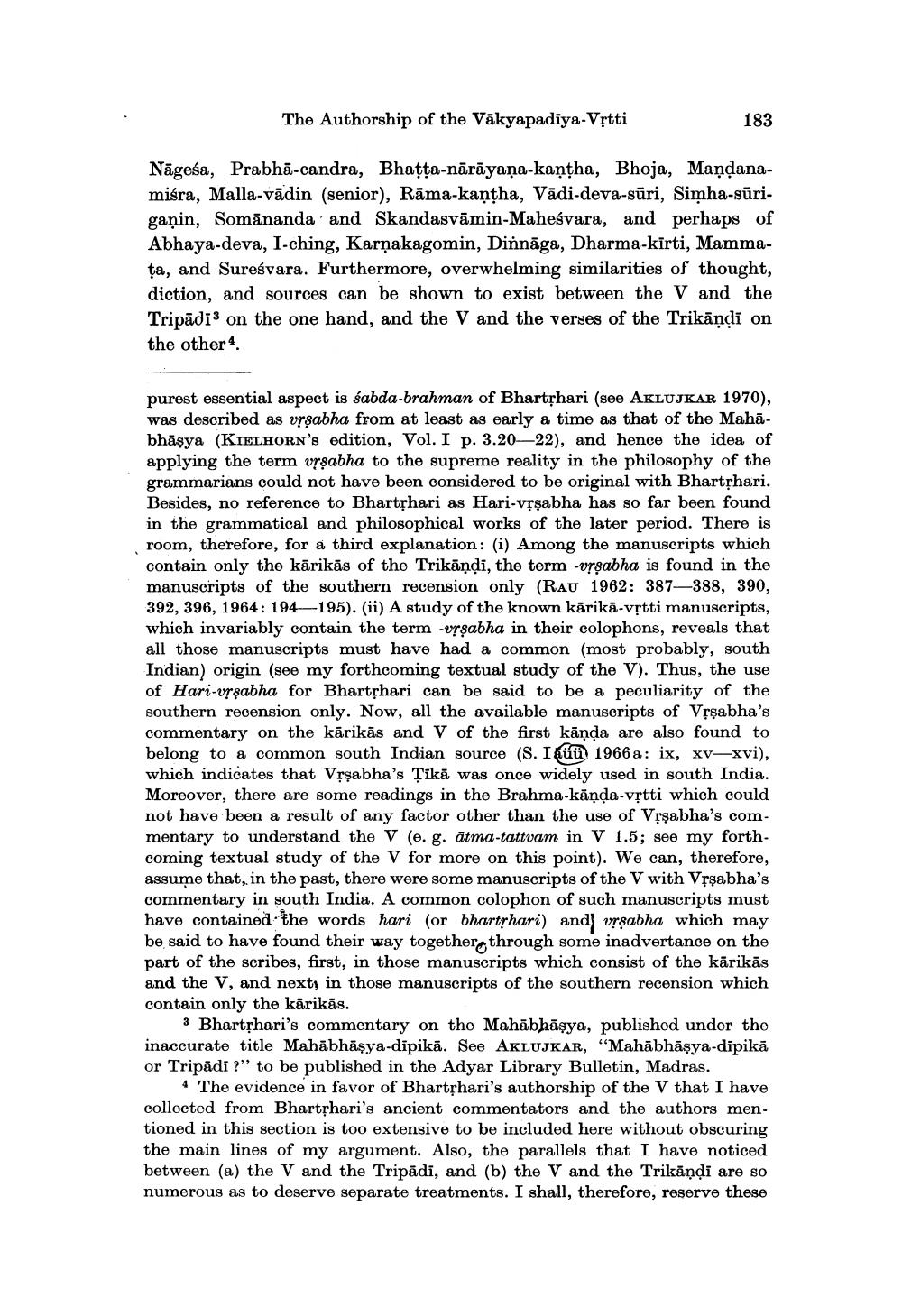Book Title: Authorship Of Vakyapadiya Vrtti Author(s): Ashok Aklujkar Publisher: Ashok Aklujkar View full book textPage 3
________________ The Authorship of the Vākyapadiya-Vrtti 183 Nāgesa, Prabhā-candra, Bhatta-nārāyaṇa-kantha, Bhoja, Mandanamišra, Malla-vādin (senior), Rāma-kantha, Vādi-deva-sūri, Simha-sūrigamin, Somānanda and Skandasvāmin-Maheśvara, and perhaps of Abhaya-deva, I-ching, Karņakagomin, Dinnāga, Dharma-kirti, Mammața, and Sureśvara. Furthermore, overwhelming similarities of thought, diction, and sources can be shown to exist between the V and the Tripādis on the one hand, and the V and the verses of the Trikāņdi on the other purest essential aspect is sabda-brahman of Bhartshari (see AKLUJKAR 1970), was described as vrşabha from at least as early a time as that of the Mahābhāşya (KIELHORN's edition, Vol. I p. 3.20—22), and hence the idea of applying the term vrsabha to the supreme reality in the philosophy of the grammarians could not have been considered to be original with Bhartshari. Besides, no reference to Bhartphari as Hari-vrşabha has so far been found in the grammatical and philosophical works of the later period. There is room, therefore, for a third explanation: (i) Among the manuscripts which contain only the kārikās of the Trikāņdi, the term -vrsabha is found in the manuscripts of the southern recension only (RAU 1962: 387-388, 390, 392, 396, 1964: 194195). (ii) A study of the known kārikā-vștti manuscripts, which invariably contain the term -vrşabha in their colophons, reveals that all those manuscripts must have had a common (most probably, south Indian) origin (see my forthcoming textual study of the V). Thus, the use of Hari-vrşabha for Bhartphari can be said to be a peculiarity of the southern recension only. Now, all the available manuscripts of Vrşabha's commentary on the kārikās and V of the first kāņda are also found to belong to a common south Indian source (S. I küü 1966 a: ix, xv—xvi), which indicates that Vrşabha's Țikā was once widely used in south India. Moreover, there are some readings in the Brahma-kānda-vrtti which could not have been a result of any factor other than the use of Vrşabha's commentary to understand the V (e. g. ātma-tattvam in V 1.5; see my forthcoming textual study of the V for more on this point). We can, therefore, assume that, in the past, there were some manuscripts of the V with Vrşabha's commentary in south India. A common colophon of such manuscripts must have contained the words hari (or bharthari) and vrşabha which may be said to have found their way together through some inadvertance on the part of the scribes, first, in those manuscripts which consist of the kārikās and the V, and next, in those manuscripts of the southern recension which contain only the kārikās. 3 Bhartshari's commentary on the Mahābhāşya, published under the inaccurate title Mahābhāşya-dipikā. See AKLUJKAR, "Mahābhāşya-dipikā or Tripādi ?" to be published in the Adyar Library Bulletin, Madras. 4 The evidence in favor of Bhartshari's authorship of the V that I have collected from Bhartshari's ancient commentators and the authors mentioned in this section is too extensive to be included here without obscuring the main lines of my argument. Also, the parallels that I have noticed between (a) the V and the Tripādi, and (b) the V and the Trikāņdi are so numerous as to deserve separate treatments. I shall, therefore, reserve thesePage Navigation
1 2 3 4 5 6 7 8 9 10 11 12 13 14 15 16 17 18
